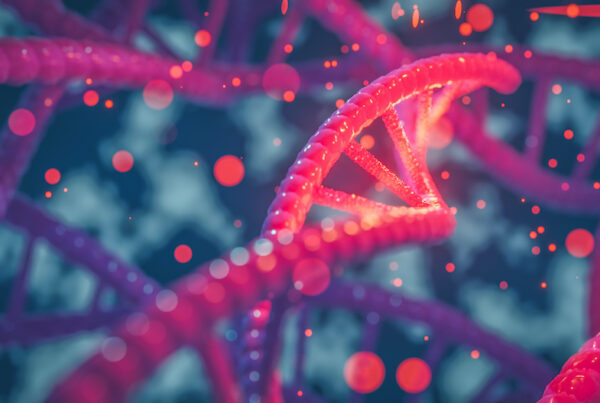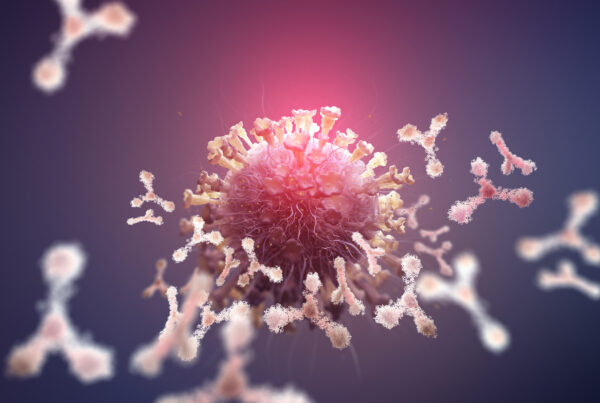The human endocrine system is incredibly complex. Many of the activities and actions that people take for granted, from eating breakfast to putting on sneakers and going for a run, are the result of a cascade of chemical reactions taking place on a molecular level.
Even the smallest actions and movements are the result of a series of signals, triggers, and responses working together to move the muscles in your hand so that you can tie your sneakers and go for that run, or to digest and metabolize the donut and coffee you ate for breakfast.
Glands like the pancreas produce hormones like insulin so that your body can properly metabolize glucose (sugar), or the pituitary gland which produces human growth hormone (GH) which helps promote tissue and bone growth throughout the body. Hormones are chemical messengers that carry instructions to the cells.
Cells need receptors to pick up the signals and activate the cell’s machinery to carry out their instructions and perform their given task. Before the hormones can reach the cells however, they need a little help from a substance known as a secretagogue to get where they’re supposed to go. MK 677 (also known as ibutamoren) is designed to act as a secretagogue for human growth hormone.
What is MK 677 (Ibutamoren)?
MK 677 (also known as Ibutamoren Mesylate) is a non-peptide ghrelin, which means it mimics the activity of a hormone receptor known as ghrelin, which among other things, works to stimulate the secretion of growth hormone in the body.
Ghrelin is a 28 amino acid peptide hormone. Ghrelin is mostly released from gastric enteroendocrine cells. The release of ghrelin can be caused by hunger, and it happens in a pulsatile manner throughout the day[1]. Ghrelin is expressed in various cells and organs, such as the stomach, testis, ovary, kidney, and small intestine [2-9]. Several studies have suggested that ghrelin-containing neurons are extensively expressed in the central nervous system (CNS) [10].
MK-0677, which is also known as ibutamoren mesylate, is a non-peptide ghrelin agonist with higher efficacy compared to ghrelin when it is bound to GHS-R1a (a ghrelin receptor) [15]. The half-life of MK-0677 is 6 hours, which is approximately 12 times longer than ghrelin’s 30 min [16].
As such, the properties of MK-0677 can be used to stimulate the ghrelin receptor.
The goal of ibutamoren therapy is to help boost the production of growth hormone and its benefits for assistance with muscle repair and healing.
The goal of ibutamoren/MK 677 is to mimic and enhance some of the known benefits of ghrelin and growth hormone, including:
- Encourage muscle growth
- Increase/maintain bone density
- Help minimize the effects of muscle wasting due to age and/or injury
- Improve sleep
- Aid with the breakdown of fat (lipolysis)
- Promote wound healing
- Lower LDL cholesterol
According to a report in the US National Library of Medicine, National Institutes of Health:
“Growth hormone secretagogues (GHSs) have been considered as alternatives in the treatment of diseases related to growth hormone (GH) deficiency because of their ability to release GH in the body.1,2,3 GHSs enhance the pulsatile release of GH in the anterior pituitary gland, resulting in sustained elevation of insulin-like growth factor (IGF)-I levels.
As GH is a large peptide molecule, it must be injected into subcutaneous tissue or muscle to get it into the blood. However, MK-677, an orally active non-peptide mimic of GHSs, can stimulate the release of GH effectively by intravenous, subcutaneous, intraperitoneal, and oral administration.4,5 Growth hormone-releasing peptide (GHRP)-6, which is a synthetic hexapeptide, also shows potent GH-releasing activity after intravenous, subcutaneous, intranasal, and oral administration in humans. MK-677 is a non-peptide spiropiperidine previously shown to be functionally and mechanistically indistinguishable in vitro and in vivo from the potent peptide GHS GHRP-6.1 MK-677 has been found to elevate GH levels, as well as IGF-I and cortisol levels, in dogs after oral administration:6 this stimulatory effect appears to depend on the presence of an intact pituitary.7
Previous studies in humans demonstrated that daily oral administration of MK-677 in healthy older adults,8 GH-deficient adults9 for 4 weeks, and GH-deficient children10 for 7 days increased serum GH, IGF-I, and IGF binding protein (IGFBP)-3 concentrations. Further, clinical trial studies of MK-677 have been conducted to improve body composition and metabolism in older adults11 or to increase bone mass in obese young males and older adults.”
 Various Benefits and Functions of MK-677
Various Benefits and Functions of MK-677
Extensive research has been done on MK-677 and its impact on various parts of the body. While not all of the research is definitively conclusive, by looking at what studies have been done, we can gain some perspective on how powerful of a peptide it can be.
Ghrelin has various effects on physiological functions, such as appetite regulation [12], adiposity [13], glucose metabolism [14], and energy homeostasis in the hypothalamus [15]. In addition, accumulating evidence for the role of the ghrelin system in cognitive functions has indicated that they are strongly correlated [11]. Low-density lipoprotein (LDL) cholesterol levels decreased in the MK-677 group relative to baseline values [23].
Possible Side Effects
The most frequent side effects were an increase in appetite that subsided in a few months and transient, mild lower-extremity edema and muscle pain [23]. Some patients noticed increased fasting blood glucose levels (5 mg/dL) and a decrease in insulin sensitivity [23].
Impact on GH, IGF-1, & Body Composition
In addition, MK-0677 increases the levels of growth hormone and insulin-like growth factor-1 [18]. Once-daily treatment of older people (64-81 years old) with oral MK-677 for up to 4 weeks enhanced pulsatile GH release, significantly increased serum GH and IGF-I concentrations, and, at a dose of 25 mg/day, restored serum IGF-I concentrations to those of young adults [18]. Changes in body composition and energy expenditure were of an anabolic nature, with a sustained increase in fat-free mass and a transient increase in basal metabolic rate [18].
Another study showed that over 12 months, once-daily treatment with 25mg of the ghrelin mimetic MK-677 enhanced pulsatile growth hormone secretion, significantly increased fat-free mass, and was generally well-tolerated in healthy older adults [21].
Impact on Sleep
In young subjects, 25mg of MK-677 treatment resulted in an approximately 50% increase in the duration of stage IV and in a more than 20% increase in REM sleep as compared to placebo. The frequency of deviations from normal sleep decreased from 42% under placebo to 8% with those using 25mg MK-677 [22].
In older adults, treatment with MK-677 was associated with a nearly 50% increase in REM sleep and a decrease in REM latency. The frequency of deviations from normal sleep also decreased. The present findings suggest that MK-677 may simultaneously improve sleep quality and correct the relative hyposomatotropism (low GH) of senescence (the condition or process of deterioration with age)[22].
Impact on Bone Health
Changes in bone mineral density consistent with increased bone remodeling occurred in MK-677 recipients [23].
Miscellaneous Impacts
Another study found that ghrelin receptor agonists could improve the poor nutritional state of malnourished patients by increasing their energy intake, ameliorating their irregular body composition, and improving their grip strength [19].
Another study found that oral dosing of a ghrelin receptor agonists normalized GI motility in opiate-induced dysmotility [20].
As with any supplement or therapeutic treatment, results and potential side effects vary from person to person. Some of the potential side effects of MK 677/ibutamoren include fatigue and lethargy, headaches, and increased blood pressure.
The Importance of Bone Strength and Muscle Mass as You Age
Even people that are healthy and active for most of their lives begin to notice changes to their body over the years. From lower energy to difficulty shedding and keeping off weight and being more prone to injuries (which may also take longer to heal), the aging process can be especially challenging for highly active and fitness-minded individuals used to pushing their body to perform at its best.
While there are no “antidotes” or “cures” for the body’s natural aging process, peptide therapy is designed to help optimize and enhance performance by mimicking and replicating the body’s own healing mechanisms.
But advanced fitness can be something of a Catch-22, especially as we get older. We know we need to exercise regularly and stay physically active as we get older, but the risks of pain and injuries also increase with age. And in many cases, even taking proactive steps like exercising regularly may not be enough to manage some of the health issues that become more common with age.
According to Harvard Health:
“Age-related muscle loss, called sarcopenia, is a natural part of aging. After age 30, you begin to lose as much as 3% to 5% per decade. Most men will lose about 30% of their muscle mass during their lifetimes.
Less muscle means greater weakness and less mobility, both of which may increase your risk of falls and fractures. A 2015 report from the American Society for Bone and Mineral Research found that people with sarcopenia had 2.3 times the risk of having a low-trauma fracture from a fall, such as a broken hip, collarbone, leg, arm, or wrist.”
One of the goals of peptide therapy treatments like MK 677 is to help compensate for the natural decline in important hormones like growth hormone and testosterone as men get older.
 Sarcopenia: An Important Side Effect of the Aging Process
Sarcopenia: An Important Side Effect of the Aging Process
It may not get as much attention as age-related bone loss and osteoporosis, but sarcopenia (age-related loss of muscle mass) also poses a significant threat to health and mobility. As the American population gets older and more and more of the Baby Boomer generation hits retirement age, age-related illnesses and injuries will account for more and more of personal savings and healthcare expenses. According to Census Bureau data, over 20% of the US population will be over age 65 by 2050.
Sarcopenia affects approximately 10% of adults and becomes more common after age 50. Under normal circumstances, the average adult loses approximately 3% muscle tone and strength every year, and the results may be even worse for people with unhealthy diets, underlying medical problems, and inactive or sedentary lifestyles.
How Sarcopenia Works
According to Healthline:
“Sarcopenia is caused by an imbalance between signals for muscle cell growth and signals for teardown. Cell growth processes are called “anabolism,” and cell teardown processes are called “catabolism” For example, growth hormones act with protein-destroying enzymes to keep muscle steady through a cycle of growth, stress or injury, destruction and then healing. This cycle is always occurring, and when things are in balance, muscle keeps its strength over time. However, during aging, the body becomes resistant to the normal growth signals, tipping the balance toward catabolism and muscle loss (1, 7).”
While sarcopenia doesn’t necessarily affect everyone, the effects of muscle and bone loss after middle age are a universal concern, whether you’re athletic and highly active, or are just concerned with preserving your health and mobility as you get older.
Lifestyle Factors and Age-Related Musculoskeletal Problems
Even with cutting edge developments in technology and therapeutic treatments like peptide therapy, there is only so much control that anyone has over genetics and biology. That’s where lifestyle factors like diet, exercise, not smoking, and drinking alcohol in moderation come in.
According to the National Institute of Arthritis and Musculoskeletal and Skin Diseases, weight-bearing and resistance training exercises are among the best for preserving bone density and building muscle mass. Some of the best exercises include:
- Walking
- Running
- Hiking
- Swimming
- Cycling
- Tennis
- Weightlifting and strength training
MK 677 is About More Than Vanity
Wanting to look and feel your best, especially as you age, is a normal and healthy goal. But investing in your physical health has far-reaching benefits beyond anti-aging efforts and six-pack abs. Strong bones and muscles are essential for protecting your body from injuries, preserving balance (a major cause of falls and age-related injuries), and even protecting cognitive health and function, as well as a happy and enjoyable quality of life.
It’s Never Too Late to Get Active and Invest in Your Health
Whether you’re a lifelong athlete or have led a predominantly sedentary lifestyle, it’s never too late to get active and work with your healthcare provider to find the best meal, supplement, and fitness plan to optimize your health and lower your risk of age-related injuries and illnesses.
Think of your health and wellness in terms of the popular Chinese proverb: The best time to plant a tree was 20 years ago. The second-best time is today.
Contact us today for more information about ibutamoren and to learn more about the benefits of peptide therapy.
References:
- Ariyasu H., Takaya K., Tagami T., Ogawa Y., Hosoda K., Akamizu T., Suda M., Koh T., Natsui K., Toyooka S., et al. Stomach is a major source of circulating ghrelin, and feeding state determines plasma ghrelin-like immunoreactivity levels in humans. J. Clin. Endocrinol. Metab. 2001;86:4753–4758. doi: 10.1210/jcem.86.10.7885.
- Tanaka M., Hayashida Y., Nakao N., Nakai N., Nakashima K. Testis-specific and developmentally induced expression of a ghrelin gene-derived transcript that encodes a novel polypeptide in the mouse. Biochim. Biophys. Acta. 2001;1522:62–65. doi: 10.1016/S0167-4781(01)00304-9.
- Caminos J.E., Tena-Sempere M., Gaytan F., Sanchez-Criado J.E., Barreiro M.L., Nogueiras R., Casanueva F.F., Aguilar E., Dieguez C. Expression of ghrelin in the cyclic and pregnant rat ovary. Endocrinology. 2003;144:1594–1602. doi: 10.1210/en.2002-221058.
- Mori K., Yoshimoto A., Takaya K., Hosoda K., Ariyasu H., Yahata K., Mukoyama M., Sugawara A., Hosoda H., Kojima M., et al. Kidney produces a novel acylated peptide, ghrelin. FEBS Lett. 2000;486:213–216. doi: 10.1016/S0014-5793(00)02308-5.
- Korbonits M., Bustin S.A., Kojima M., Jordan S., Adams E.F., Lowe D.G., Kangawa K., Grossman A.B. The expression of the growth hormone secretagogue receptor ligand ghrelin in normal and abnormal human pituitary and other neuroendocrine tumors. J. Clin. Endocrinol. Metab. 2001;86:881–887. doi: 10.1210/jc.86.2.881.
- Date Y., Kojima M., Hosoda H., Sawaguchi A., Mondal M.S., Suganuma T., Matsukura S., Kangawa K., Nakazato M. Ghrelin, a novel growth hormone-releasing acylated peptide, is synthesized in a distinct endocrine cell type in the gastrointestinal tracts of rats and humans. Endocrinology. 2000;141:4255–4261. doi: 10.1210/endo.141.11.7757.
- Hattori N., Saito T., Yagyu T., Jiang B.H., Kitagawa K., Inagaki C. GH, GH receptor, GH secretagogue receptor, and ghrelin expression in human T cells, B cells, and neutrophils. J. Clin. Endocrinol. Metab. 2001;86:4284–4291. doi: 10.1210/jcem.86.9.7866.
- Volante M., Allia E., Gugliotta P., Funaro A., Broglio F., Deghenghi R., Muccioli G., Ghigo E., Papotti M. Expression of ghrelin and of the GH secretagogue receptor by pancreatic islet cells and related endocrine tumors. J. Clin. Endocrinol. Metab. 2002;87:1300–1308. doi: 10.1210/jcem.87.3.8279.
- Kojima M., Hosoda H., Date Y., Nakazato M., Matsuo H., Kangawa K. Ghrelin is a growth-hormone-releasing acylated peptide from stomach. Nature. 1999;402:656–660. doi: 10.1038/45230.
- Lu S., Guan J.L., Wang Q.P., Uehara K., Yamada S., Goto N., Date Y., Nakazato M., Kojima M., Kangawa K., et al. Immunocytochemical observation of ghrelin-containing neurons in the rat arcuate nucleus. Neurosci. Lett. 2002;321:157–160. doi: 10.1016/S0304-3940(01)02544-7.
- Bailey A.R., Smith R.G., Leng G. The nonpeptide growth hormone secretagogue, MK-0677, activates hypothalamic arcuate nucleus neurons in vivo. J. Neuroendocrinol. 1998;10:111–118. doi: 10.1046/j.1365-2826.1998.00176.x.
- Howick K., Griffin B.T., Cryan J.F., Schellekens H. From Belly to Brain: Targeting the Ghrelin Receptor in Appetite and Food Intake Regulation. Int. J. Mol. Sci. 2017;18 doi: 10.3390/ijms18020273.


 Various Benefits and Functions of MK-677
Various Benefits and Functions of MK-677 Sarcopenia: An Important Side Effect of the Aging Process
Sarcopenia: An Important Side Effect of the Aging Process

